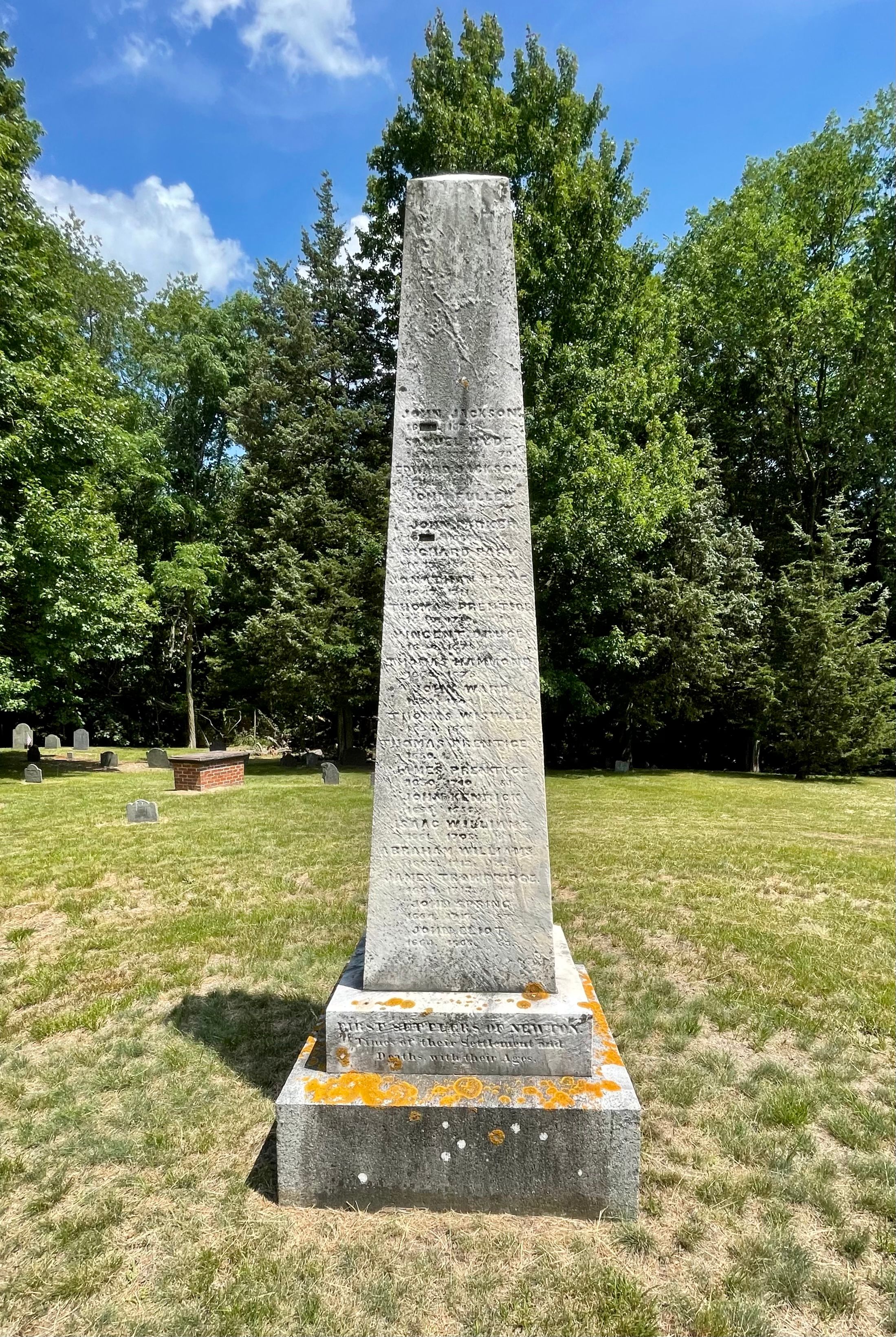CHILDREN:
Margaret Jackson
Mary Jackson
Edward Jackson
Abigail Jackson
Abraham Jackson
History of Newton
Page 86
John Jackson was baptized in the parish of Stephney, London, June 6, 1602. He was the first settler of Cambridge Village who removed thither and died in the place. He brought a good estate with him from England. He took the freeman oath in 1641. He was one of the first deacons of the church, and gave an acre of land for the church and cemetery, in the centre of which the first meeting-house was erected in 1660. This acre constitutes the oldes part of the old cemetery on Centre Street. He labored long and earnestly, by petitioning the General Court and otherwise, to have Cambridge Village erected into an independent town; but he did not live to see the object accomplished. He died January 30, 1674-5, aged about 73 years. His widow, Margaret, died August 28, 1684, aged 60. His son, Edward, was slain by the Indians at Medfield,, in their attack upon and burning of that town, Feb. 21, 1676. His house was near the place where Mr. Smallwood's shop afterwards stood. The cellar yet remains, and the pear trees now standing there, ar supposed to have been planted by him. Abraham was the only one among his sons who reared a family.
From the History of Newton, Page 142
Jackson, Deacon John (d. 1675), the first settler of Cambriddge Village, who remained and died in it. In 1639, he bought of Miles Ives, of Watertown, a dwelling-house and eighteen acres of land, situated on the Roxbury road, very near the line which now divides Newton from Brighton. It was he who gave an acre of land for the first meeting-house and burial place, now the oldest part of the old cemetery on Centre Street. His old mansion house, which was pulled down about 1800, stood on the spot afterwards occupied by the dwelling-house of Edwin Smallwood. The old pear trees on the estate are supposed to have been planted by his son Abraham, who added an acre to the acre given by his father for the meeting-house and burial place. He left eight hundred and sixty-three acres of land.
Deacon Jackson's Headstone no longer exists at the burying ground.
THIS IS THE MONUMENT TO THE FIRST SETTLERS OF CAMBRIDGE VILLAGE, NOW KNOWN AT NEWTON, MA.
CHILDREN:
Margaret Jackson
Mary Jackson
Edward Jackson
Abigail Jackson
Abraham Jackson
History of Newton
Page 86
John Jackson was baptized in the parish of Stephney, London, June 6, 1602. He was the first settler of Cambridge Village who removed thither and died in the place. He brought a good estate with him from England. He took the freeman oath in 1641. He was one of the first deacons of the church, and gave an acre of land for the church and cemetery, in the centre of which the first meeting-house was erected in 1660. This acre constitutes the oldes part of the old cemetery on Centre Street. He labored long and earnestly, by petitioning the General Court and otherwise, to have Cambridge Village erected into an independent town; but he did not live to see the object accomplished. He died January 30, 1674-5, aged about 73 years. His widow, Margaret, died August 28, 1684, aged 60. His son, Edward, was slain by the Indians at Medfield,, in their attack upon and burning of that town, Feb. 21, 1676. His house was near the place where Mr. Smallwood's shop afterwards stood. The cellar yet remains, and the pear trees now standing there, ar supposed to have been planted by him. Abraham was the only one among his sons who reared a family.
From the History of Newton, Page 142
Jackson, Deacon John (d. 1675), the first settler of Cambriddge Village, who remained and died in it. In 1639, he bought of Miles Ives, of Watertown, a dwelling-house and eighteen acres of land, situated on the Roxbury road, very near the line which now divides Newton from Brighton. It was he who gave an acre of land for the first meeting-house and burial place, now the oldest part of the old cemetery on Centre Street. His old mansion house, which was pulled down about 1800, stood on the spot afterwards occupied by the dwelling-house of Edwin Smallwood. The old pear trees on the estate are supposed to have been planted by his son Abraham, who added an acre to the acre given by his father for the meeting-house and burial place. He left eight hundred and sixty-three acres of land.
Deacon Jackson's Headstone no longer exists at the burying ground.
THIS IS THE MONUMENT TO THE FIRST SETTLERS OF CAMBRIDGE VILLAGE, NOW KNOWN AT NEWTON, MA.









